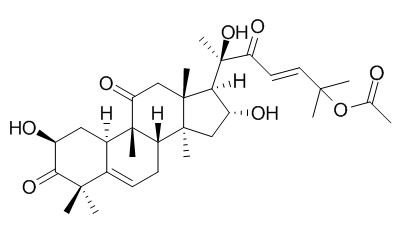Natural Products
Cucurbitacin B
| Catalog No. | CFN99129 |  |
| CAS No. | 6199-67-3 | |
| Molecular Weight: | 558.70 | |
| Molecular Formula | C32H46O8 | |
| DBs | [PubChem]:274951289 [ChEMBL]:3941 [PCIDB]:3683 |
Standard InChI:
InChI=1S/C32H46O8/c1-17(33)40-27(2,3)13-12-23(36)32(9,39)25-21(35)15-29(6)22-11-10-18-19(14-20(34)26(38)28(18,4)5)31(22,8)24(37)16-30(25,29)7/h10,12-13,19-22,25,34-35,39H,11,14-16H2,1-9H3/b13-12+/t19-,20+,21-,22+,25+,29+,30-,31+,32+/m1/s1
Biological Activity
Cucurbitacin B (cucB) is a triterpenoid constituent of Cucurbitaceae vegetables and a promising phytochemical for cancer prevention, cucB induces G(2) arrest and apoptosis through a STAT3-independent but ROS-dependent mechanism in SW480 cells.[1]
Cucurbitacin B has antiproliferative effect, can induce apoptosis by inhibition of the JAK/STAT pathway and potentiates antiproliferative effects of gemcitabine on pancreatic cancer cells, may be an effective, new approach for the treatment of ER-, Her2/neu amplified, and p53 mutant breast cancers.[2,3]
Combination of cucurbitacin B at a relatively low concentration with either of the chemotherapeutic agents, docetaxel (DOC) or gemcitabine (GEM) , shows prominent antiproliferative activity against breast cancer cells without increased toxicity, this promising combination should be examined in therapeutic trials of breast cancer.[4]
Cucurbitacin B has anti-cutaneous squamous cell carcinoma (CSCC) activity by inhibiting growth, arresting the cell cycle, and synergistically potentiate the anti-proliferative effect of cisplatin in CSCC.[5]
Cucurbitacin B a selective inhibitor of JAK2/STAT3 signaling, could promote dendritic cells (DCs) differentiation and improve antitumor immunity, also significantly reduce the frequency of imCs in patients with lung cancers and enhance the effect of p53-specific CTL on tumor 16HBE/BPDE cells.[6]
Product
References
[1] Yasuda S, Yogosawa S, Izutani Y, et al. Mol Nutr Food Res, 2010, 54(4):559–65.
[2] Thoennissen N H, Iwanski G B, Doan N B, et al. Cancer Res, 2009, 69(14):5876-84.
[3] Wakimoto N, Dong Y, O’Kelly J, et al. Cancer Sci, 2008, 99(9):1793–7.
[4] Aribi A, Sigal Gery ‡, Lee D H, et al. Int J Cancer, 2013, 132(12):2730–7.
[5] Chen W, Leiter A, Yin D, et al. Int J Oncolo, 2010, 37(3):737-43.
[6] Lu P, Yu B, Xu J. Cancer Biother Radio, 2012, 27(27):495-503.
[7] Sun W, Chao Z M, Wang C, et al. Chinese Journal of Experimental Traditional Medical Formulae ,2014, 20(23):86-8.
Product Use Citation





